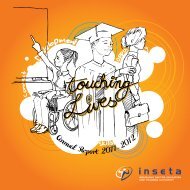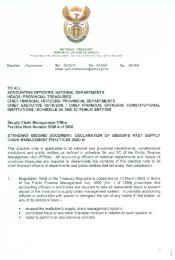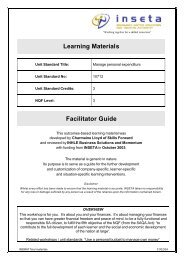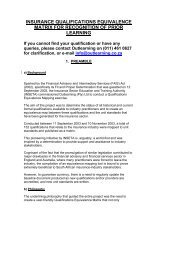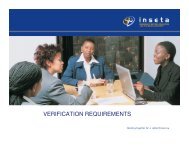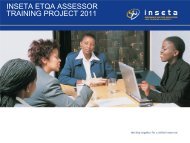SSP Brochure:Layout 1 - INSETA
SSP Brochure:Layout 1 - INSETA
SSP Brochure:Layout 1 - INSETA
Create successful ePaper yourself
Turn your PDF publications into a flip-book with our unique Google optimized e-Paper software.
In respect of the population group and gender composition of new graduates, a marked change has occurred in recent years. In 1992,only 18% of all learners who qualified in business, commerce and management sciences were black. By 2004, 60% of the learnerswere black. Similarly, women’s share in qualifications in this field increased from 39% in 1992 to 53% in 2004. 55The situation with regard to the specific professional qualifications that are relevant to this sector looks somewhat different. Actuarialqualifications are important to the insurance sector (although they are not used exclusively in this sector). Actuaries currently qualifyat a rate of approximately 60 a year, and there are at present some 770 qualified actuaries in South Africa. According to the ActuarialSociety of South Africa, South Africa should have sufficient actuaries (where supply equals demand) in the next five to ten years.However, qualified actuaries are predominantly white men. 56The FPI has some 3 000 certified financial planners as members who have completed the Postgraduate Diploma in Financial Planning(NQF level 7) and some 1 200 members who are currently studying towards this qualification. The FPI also has 4 400 members whohave achieved qualifications at NQF levels 5 and 6. Most of these professionals are white.Chartered accountants also play a key role in this sector. At the end of April 2006, approximately 24 737 chartered accountants wereregistered with the South African Institute for Chartered Accountants (SAICA). In the period April 2002 to April 2006, the totalnumber of chartered accountants increased by 5% a year. This profession also consists mainly of whites and the profile is changingvery slowly. In June 2002, only 7% of all chartered accountants were black. By 2006, blacks’ share in the profession had increased to11%. Of the 9 751 learners on CA learnerships at the end of April 2006, 39% were black. 57c) Projection of new entrants from the public HET sectorThe number of Bachelor’s degrees, BTech degrees and national diplomas provides a measure of the number of new entrants to thelabour market from the public HET sector. 58 Figure 3.6 shows the number of new graduates who qualified between 1999 and 2004,and the number that will qualify per annum if the average annual growth rate is sustained. The HET sector could produce as manyas 132 700 new graduates in the five-year period 2005 to 2009. This, however, depends on a number of factors, including the capacityof the HET sector to sustain this level of growth (especially in the context of the restructuring of HET institutions that is currentlytaking place) and the DoE’s subsidisation of the HET sector.Figure 3-6 Actual and projected entry-level qualifications in business, commerce and management sciences from the public HETsector*Figures projected, using the average annual growth rate observed for the period 1999 to 2004Sources: Calculated from DoE, HEMIS Table 2.13, 1999 to 2004 and own projections from 2005 to 2010.55 SAQA, Trends in Public Higher Education in South Africa:1992 to 2001. Pretoria, October 2004 and 1995 to 2004, June 2007.56 Information obtained from the Actuarial Society of South Africa during the <strong>SSP</strong> update process in 2007.57 Calculated from information published by SAICA,http://www:saica.co.za.58 No figures are currently available on the output from the private HET institutions.<strong>INSETA</strong> Sector Skills Plan - page 28





